iMScope QT - Features
Imaging Mass Microscope
결합 분석
광학 현미경의 관찰 결과와 MS 이미지의 융합
(시마즈 독점)
MS 이미지는 유연하게 얻을 수 있으며, 전체 이미지 영역이나 세부적인 부분 중 하나인 관찰 이미지와 교차 비교를 할 수 있습니다.
5μm 공간 해상도의 소뇌(Cerebellum) 측정 결과
- 샘플:쥐의 뇌
- 매트릭스:9-AA
- 측정 영역 :662×595(393890pix)
- 측정 시간: :약 2.2 시간

아래 빨간색 프레임(소뇌)의 영역은 5μm의 해상도로 측정했습니다. 광학 현미경을 사용한 고해상도 MS 이미징과 형태학적 관찰은 최첨단 연구를 지원합니다.
Negative 모드에서 전체 뇌 섹션에 대한 측정 결과
- 샘플:쥐의 뇌
- 매트릭스:9-AA
- 측정 영역 :1126×624(702624pix)
- 측정 시간:약 6 시간

마우스 뇌의 단면(17mm × 9.4mm)을 15μm 간격 (702,624pix)로 고해상도로 측정했습니다. 이 큰 뇌 단면의 고해상도 분석은 약 6시간 만에 완료되어 테스트가 효율적으로 진행될 수 있었습니다.
정량화 및 분포
단일 기기로 LC-MS로부터 정성적 및 정량적 정보와 질량 분석 이미징(MSI)으로부터 위치 정보를 얻습니다.
MSI 분석 외에도 LC-MS 분석을 수행할 수 있는 결합 시스템은 분포 정보와 정량 분석을 모두 제공합니다.
chlorpromazine이 투여된 마우스 조직의 단면을 iMScope QT로 측정했습니다. 라벨링 없이도 농도 차이를 포함한 변경되지 않은 chlorpromazine의 분포를 시각화 할 수 있었습니다.

연속된 섹션에서 위 그림에서 동그라미 친 위치를 레이저 미세 해부(LMD)를 사용하여 절제하고 추출된 액체를 LCMS-9030으로 측정했습니다
아래 결과는 LabSolutions Insight™를 사용하여 추출한 액체의 chlorpromazine 농도를 정량적으로 분석한 결과를 보여줍니다. 이러한 방식으로 LC-MS를 사용하여 결정한 정량 결과를 통해 MSI로 표시된 조직 섹션에서 의약품의 농도 차이를 확인할 수 있습니다.
또한 LabSolutions Insight Explore™ 조성 추정 함수를 사용하여 미지의 화합물의 분자식을 추정할 수 있습니다
이 경우, MSI를 사용하여 결정된 m/z = 319.10에서의 Peak를 조성 추정 함수를 사용하여 분석했을 때, 변경되지 않은 chlorpromazine 물질(C17H19N2SCl)의 분자식이 가장 높은 점수를 받을 가능성이 높은 것으로 나타났습니다.
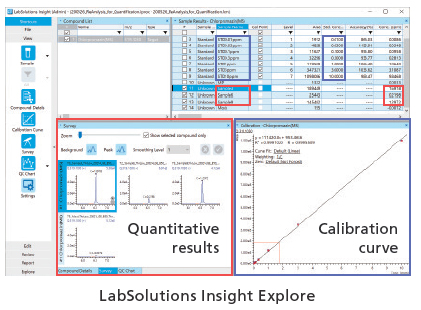
| 이온 형태 | 이론 값 | 측정 값 | 차이 (mDa) |
| [M+H]+ | 319.10302 | 319.10317 | +0.15 |
결과: 최고 점수 98.99, 차이. 0.15 mDa (0.458 ppm), C17H19N2SCl
고해상도, 속도 및 정확성
정확하고 고속이며 고해상도의 MS 이미지와 효율적인 데이터 분석
고정밀 고속 LCMS-9030*과 고해상도 질량 분석 이미징의 결합
혁신적인 고성능 분석 시스템
내장된 광학 현미경으로 스캔한 후 샘플 플레이트를 이온화 위치로 직접 이동시키고 이미징 프로세스를 시작합니다.
* LCMS-9030은 별도로 판매됩니다
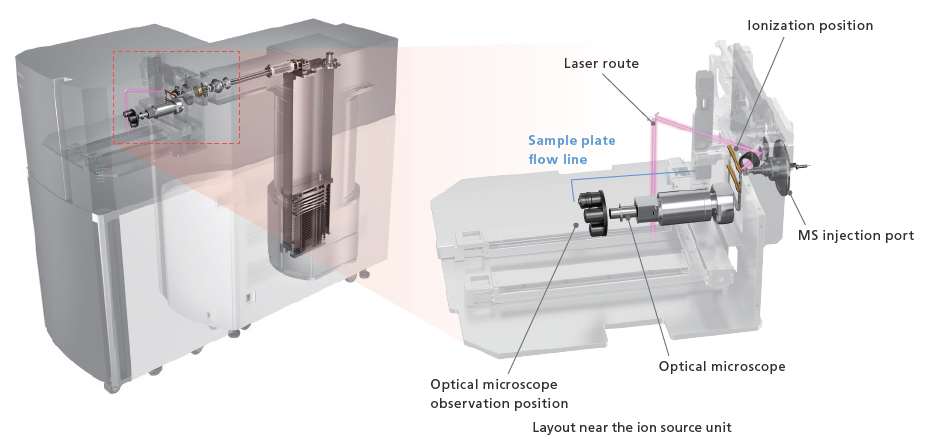
Designed for Easy Attachment
The iMScope QT can be easily attached or detached from the LCMS-9030 to switch between mass spectrometry imaging and high-sensitivity LC-MS analysis.
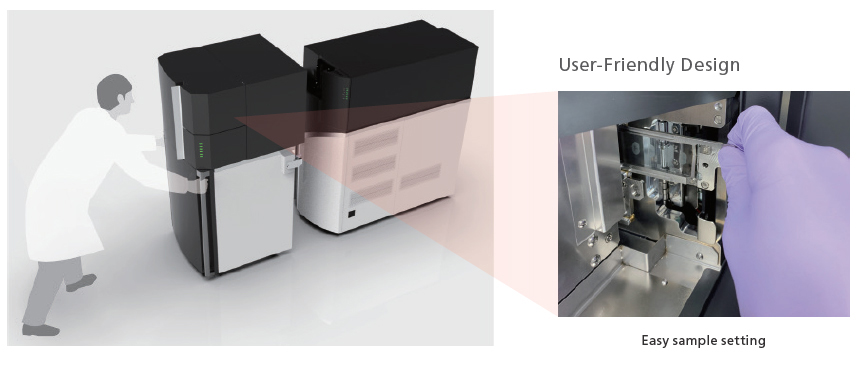
Effortless Performance for Accurate Mass
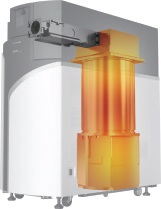
Excellence in Mass Measurement Accuracy (MMA)
Mass measurement accuracy (MMA) is the key performance attribute underlying all application fields using high-resolution accurate-mass (HRAM) spectrometers. The LCMS-9030 delivers the MMA needed for high-con dence identification of unknown compounds at an unprecedented level of stability. This is made possible by new technologies implemented in the Intelligent Temperature Control System and the UF-FlightTube that accurately offset the changes occurring to both internal and external environments. With the LCMS-9030, Shimadzu aims to totally refashion the HRAM user experience, enabling scientists to run more samples at longer calibration intervals with greater confidence and ease.
Stable MMA Against Temperature Fluctuation
Shimadzu’s Intelligent Temperature Control System ensures stable MMA even in laboratory environments susceptible to temperature changes. To demonstrate, standards ranging from 150 to 1700 Da were analyzed continuously after a single calibration. Normal laboratory temperature fluctuation was observed between 25°C and 28°C.
Without additional mass correction, the measured accurate masses of all compounds remained within 1 ppm of the theoretical mass for the 60-hour duration of the experiment. With the LCMS-9030, laboratory productivity can be increased by running long, calibration-free batches with confidence.
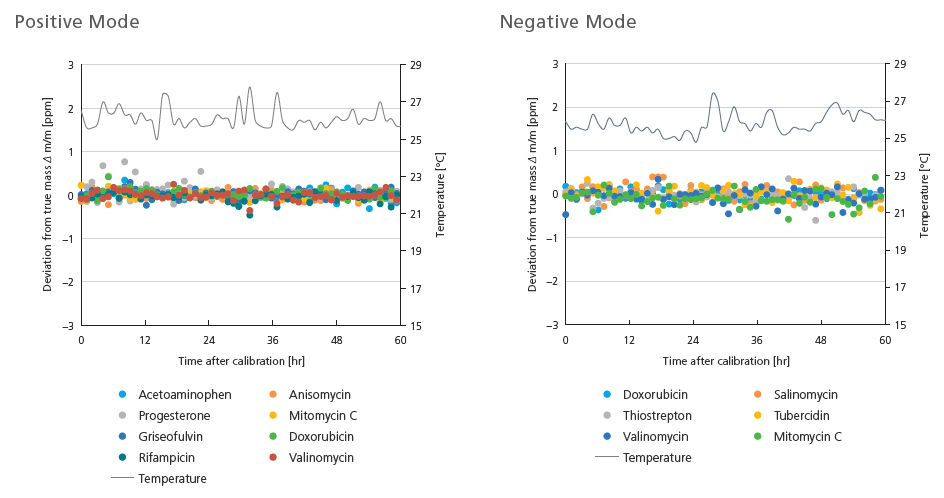
다중 모드 이미징 시스템
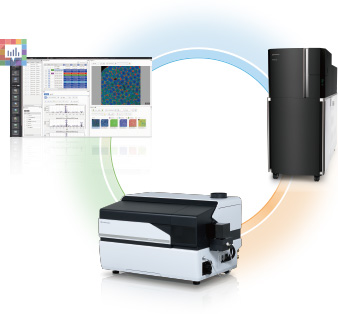
MALDI-MS 분자 이미징 데이터와 LA-ICP-MS 원소 이미징 데이터는 단일 소프트웨어 솔루션을 사용하여 분석할 수 있습니다. 이를 통해 다중 모드 이미징에 대한 접근성을 높일 수 있습니다.
Downloads
Download the latest brochure.


